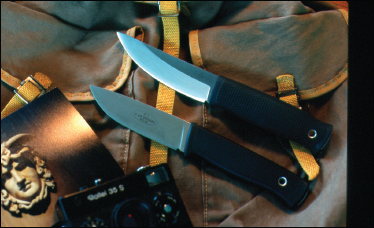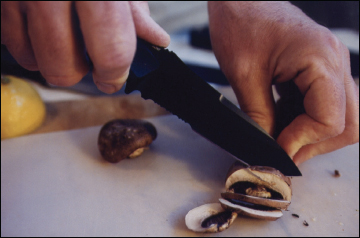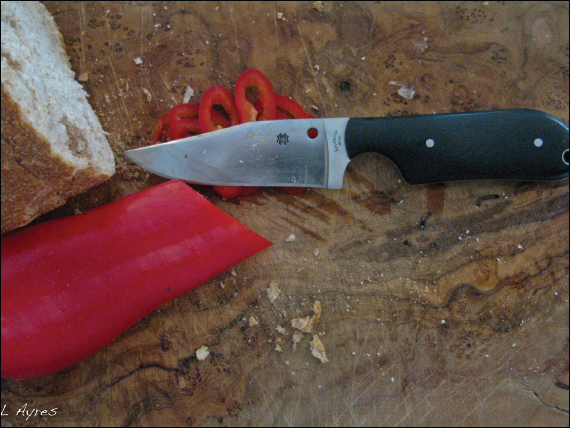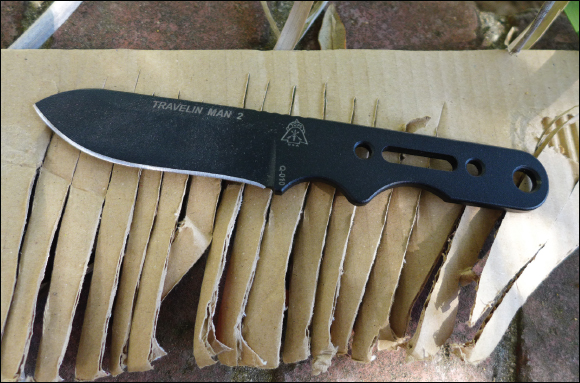
Chapter 17
The International Traveler’s Tactical Knife
Let’s follow the logic of what we have learned in the previous chapters. Big knives are great but won’t be carried on your person. Medium knives, around seven inches, are still too big for convenient civilian carry, and in most cases we don’t need their war function. Small woodcarving and wilderness-oriented knives are not strong enough for emergency use. What does that leave us with, folders aside? If we want a tactical and survival knife, one suitable for daily carry in all kinds of conditions, we’re looking at knives in the four-to-five-inch blade range with reserves of strength. This category of knives is one that for years I have called traveler’s knives.
I do so because I have lived much of my life as an international traveler, and after thirty years, six continents, and more than forty countries, after five star hotels and jungle camps, war zones, third world slums, and palm-fringed islands, I have found this to be the most essential tool and emergency weapon I can have with me. That’s aside from firearms or a SatCom that would allow me to call in an air strike and an extraction team. (Joke. Mmm, not really.)

Traveler’s knives.
Anything can happen on the road and often does. I have thought about this topic at length and considered the needs of others I have encountered in my travels, some of which I have written about in earlier chapters. Recreational travelers, especially the international adventure traveler, might experience any climate or terrain. A traveler might encounter emergency situations or have a walk in the sun. He or she may travel alone or in company, friendly or unfriendly. In all cases, he or she should be self-reliant. His or her primary knife must serve planned and unplanned needs in all circumstances and environments. It might be the only tool available in an emergency.
A traveler is far from home and often unable to replace broken gear. He or she also should try to travel as lightly as possible. Therefore, the traveler’s primary knife must be useful for a wide range of everyday tasks and have a reserve of strength for extreme situations. It must take a good edge and be easy to sharpen. It must not break. It must be useful for everything from slicing tomatoes and ripping coconuts open to arresting a slide down the slimy interior wall of an aqueduct. For the knife to be available, it should be on the traveler’s person, except when it is checked with luggage for flying or in other secured areas. It seems to me that most of this also applies to the person who only travels a few miles from home. Who knows what will happen when you step out of your door? As Bilbo Baggins said in J.R.R. Tolkien’s The Fellowship of the Ring, “It’s a dangerous business, Frodo, going out your door. You step onto the Road, and if you don’t keep your feet, there’s no knowing where you might be swept off to.” The Lord of the Rings is a fantasy series, but that message demonstrates wisdom. So where does all this take us?
Right back to where we started. A tough, sharp fixed blade about four to five inches in length, essentially a small tactical and survival knife, is the best compromise between function, size, convenience, and social acceptability. My experiences have led me to realize the wisdom of equipping US military pilots from World War II on with the Pilot’s Survival Knife. It is, in all essentials, also a traveler’s knife and will serve a traveler’s needs well.
No folder, even an automatic, is faster to open than a fixed blade that’s already open. No folder can be as strong as a tough fixed blade. The shorter blade will do almost everything the longer blades will do, and it will be there when you need it. And if you travel far off the beaten track, you will need it.
You’ll find many good choices in this category when you get to the review section. But for now, here are a few examples of knives I have used and been satisfied with.

Chris Reeve Shadow III, Chris Reeve Mountaineer I, Fällkniven F1, Fällkniven H1, Spyderco Bob Lum, and Spyderco Fred Perrin.

Fällkniven F1 and H1 with traveler’s gear.

Benchmade Nimravus.
On an extended trip a few years ago, I carried a Chris Reeve Mountaineer I daily. I used it for food preparation and daily chores in camp and around town. While visiting an archaeological excavation in France, I was trapped underground when the staff left and locked the security door—the only way out—behind them. I was in no immediate danger, but I was facing a long, hungry weekend before anyone returned on Monday morning. The excavation tools—shovels, picks, etc.—were stored in a shed aboveground. The only tool I had with me was the little Reeve.
I decided to attempt jimmying the security door open. I had doubts that the small knife would survive the effort or open the door, but dinner beckoned. I slid it into the crack near the lock and slowly applied pressure. Bit by bit the door gave. Bit by bit the blade flexed. I thought the diminutive blade might break, but I continued to apply pressure. Finally the door popped open, the blade sprang back to true, and I escaped in time for some roast duck with a nice Beaujolais.
This story is an illustration of the value of a fixed blade and the have it with you principle. The strongest folder I have ever seen would have folded up if I had tried to pry open that door with it. If I had not had the knife with me, there would have been no roast duck and no Beaujolais, just a long weekend underground with some recently excavated skeletons. The other version of this tiny powerhouse, the Shadow III, is just as strong, perhaps more so since its spear point has more steel close to the point.
Fällkniven have two models in the short and stout category. The H1 and F1 are both about eight inches overall, full-tang knives made of V10. Both knives have survived without damage the depredation caused by groups of teenagers in survival classes. Their convex grinds provide efficient edge geometry and strength. I’ve been using the H1 and the F1 for years and like both of them a great deal. These are excellent examples of what the traveler’s knife should be.

An old favorite fixed blade, Spyderco’s Bob Lum Tanto.

Spyderco Fred Perrin Street Beat, the perfect traveler’s companion.

Bud Nealy Cave Bear II © Bud Nealy.

TOPS Travelin Man 2, a reliable, tough example of a traveler’s knife.
Benchmade’s Nimravus is another good choice, although I would prefer if they offered the knife with a plain blade instead of a black one, which can draw unwanted attention in civilian use. At nine inches overall, it is a bit longer than the Reeves and Fällknivens but still a handy size. The Nimravus also survived the terrible teens during a shelter-building class. No joke. Untrained teenagers can destroy a piece of equipment faster than anyone but a parent would think possible. Benchmade also catalogs a shorter version of the Nimravus called the Cub. It should also work fine for the traveler.
Spyderco’s Bob Lum Tanto is also a good choice for a traveler’s knife; its VG-10 blade is strong, takes a good edge, and holds it well. Fred Perrin’s Street Beat and Street Bowie, both in the Spyderco versions and Fred’s handmade versions, are excellent traveler’s knives. Our group has used both over a period of years, sometimes well outside of their design parameters, and has found them to be reliable, handsome, comfortable, well balanced, and all-around great knives.
Check out the Bud Nealy knives in the review section to find some nice traveler’s knives. Many of Bud’s knives have a self-defense focus, but they are equally useful as basic tactical, survival, or traveler’s knives. Bud also has a new batch of models specifically designed for backpackers and outdoorsmen that will work well for travelers.
These are not the only knives suitable for the adventure traveler, but they are good examples. To evaluate a knife for extreme use, you might want to try some of the things I outline in the section on reviewing knives.
Still, let’s not forget the utility of the big knife. A big knife of some kind is indispensable in the bush, but more or less useless in the city. If you know you will be traveling in the bush, it is worthwhile to pack one. Otherwise, for spontaneous trips afield, I buy a parang machete, bolo, or something similar at the local market.
As a traveler to far away places, you might also want a little back up. One of the tiny lockbacks pioneered by Spyderco, such the Cricket or Dragonfly, clip to any part of your clothing, open with one hand, lock solid, and cut like miniature chainsaws. The serrated models will easily slash though a seat belt. They provide much greater utility than their size might indicate.
You might also want an Swiss Army Knife. I don’t really think of SAKs as knives; they’re more like pocket tool kits. A small, simple one is best. But an SAK without a corkscrew is no SAK at all. Be prepared, right? Who knows when a bottle of Beaujolais or Bordeaux might happen along?
You can load yourself down with a dozen knives and a hundred pounds of gear before you hit the road. But after a while you will find that you only need a minimum of equipment. A few years ago, I walked across a good bit of Italy with a ten-pound pack and a Fällkniven F1. Some time back, I carried even less while island hopping for months in the Southern Philippines. I have found that travel has a way of bringing you to simplicity and clarity about your needs in life, as well as on the road. If you travel off the beaten track, take a small, strong fixed blade. Don’t leave home without it.